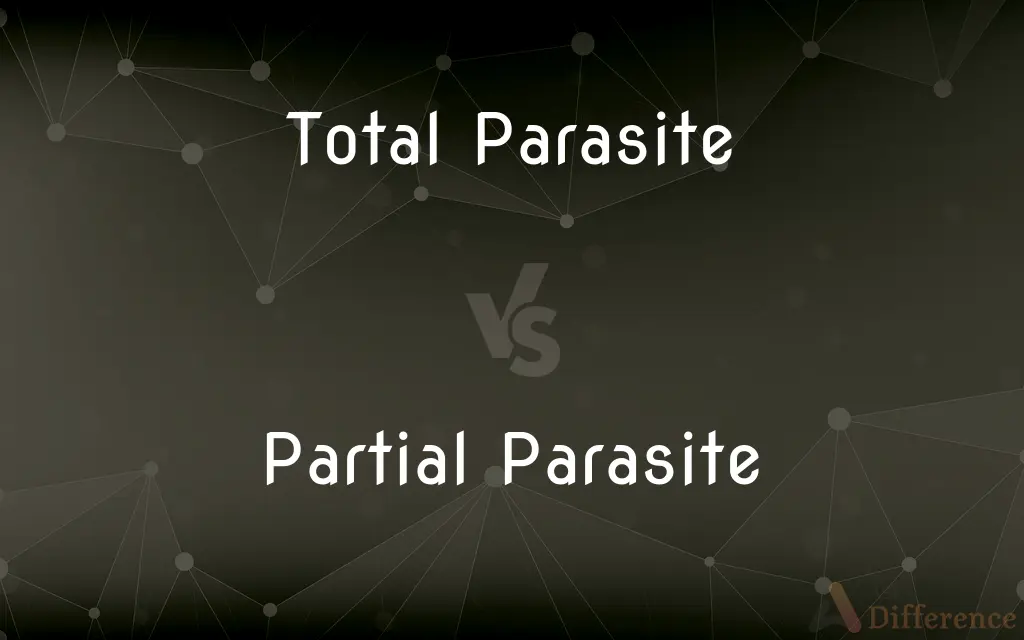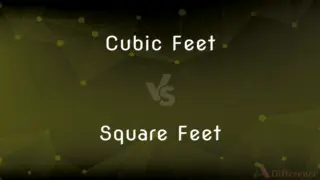Total Parasite vs. Partial Parasite — What's the Difference?
By Tayyaba Rehman — Published on November 13, 2023
A Total Parasite derives all its nutrients from a host plant, lacking chlorophyll, while a Partial Parasite, possessing chlorophyll, relies on its host only for certain nutrients.

Difference Between Total Parasite and Partial Parasite
Table of Contents
ADVERTISEMENT
Key Differences
A Total Parasite is an organism that is fully dependent on its host for survival. These parasites lack chlorophyll, meaning they cannot perform photosynthesis and thus, cannot produce their own food.
On the other hand, a Partial Parasite is not entirely reliant on its host for all its needs. These organisms have chlorophyll and can carry out photosynthesis. This means they can generate some of their food independently.
The relationship a Total Parasite has with its host is comprehensive. From water to all essential nutrients, everything is sourced from the host. This exhaustive dependency often results in significant harm or even death to the host.
In contrast, the bond a Partial Parasite forms with its host is not as consuming. It taps into the host mainly for water and specific nutrients. Since they can photosynthesize, they don't deplete the host as aggressively as Total Parasites.
While both Total Parasites and Partial Parasites engage in parasitic relationships, the depth of their reliance varies. The former extracts everything, while the latter maintains some self-sufficiency.
ADVERTISEMENT
Comparison Chart
Dependency on Host
Fully dependent
Partially dependent
Chlorophyll Presence
Lacks chlorophyll
Possesses chlorophyll
Photosynthesis Capability
Cannot perform
Can perform
Nutrient Source
Entirely from host
From both host and photosynthesis
Effect on Host
Generally more harmful
Less harmful compared to Total Parasites
Compare with Definitions
Total Parasite
Plants or organisms fully parasitizing, having lost self-sufficiency.
As a Total Parasite, the hydnora plant cannot survive without a host to feed on.
Partial Parasite
A parasitic entity that still retains chlorophyll and can perform photosynthesis.
The Indian paintbrush, a Partial Parasite, showcases vibrant colors while tapping nutrients from other plants.
Total Parasite
A life form that derives all sustenance from another organism, often harming it.
Total Parasites like the witchweed can severely deplete crops by taking all their nutrients.
Partial Parasite
An organism that relies on its host for certain nutrients while producing others via photosynthesis.
Mistletoes are Partial Parasites, drawing water from trees but photosynthesizing for some food.
Total Parasite
A parasitic entity devoid of chlorophyll and incapable of photosynthesis.
The broomrape, being a Total Parasite, doesn't green up as it lacks chlorophyll.
Partial Parasite
Plants or organisms that exhibit a mix of self-sufficiency and parasitism.
The beechdrops plant, as a Partial Parasite, borrows some essentials but can also generate its own food.
Total Parasite
An organism entirely reliant on its host for nutrients.
The dodder plant is a Total Parasite, completely depending on its host for sustenance.
Partial Parasite
A life form partially dependent on another organism for sustenance.
Partial Parasites like the yellow rattle can photosynthesize but also siphon from hosts.
Total Parasite
An entity that has no capability to produce its own food.
Rafflesia, a Total Parasite, relies wholly on its host, extracting everything it needs.
Partial Parasite
An entity with both parasitic tendencies and an ability for independent food production.
The sandalwood tree, a Partial Parasite, taps into other tree roots while also photosynthesizing.
Common Curiosities
How does a Partial Parasite differ from a Total Parasite?
While both are parasitic, Partial Parasites can perform photosynthesis, unlike Total Parasites.
What's a common example of a Total Parasite?
Dodder is a well-known Total Parasite.
What allows Partial Parasites some independence from their host?
They possess chlorophyll, enabling them to generate some of their own food.
Do Total Parasites have roots?
Often, they have modified roots that penetrate the host to draw nutrients.
a Total or Partial Parasite?
Typically, Total Parasites are more harmful due to their complete dependency.
Do Partial Parasites always need to be on a host?
They typically need a host for optimum growth, but not necessarily for survival.
What is a Total Parasite?
A Total Parasite is an organism completely dependent on a host for all nutrients.
Do Total Parasites have chlorophyll?
No, Total Parasites lack chlorophyll and can't photosynthesize.
How do Partial Parasites obtain water?
They often tap into their host's roots to draw water.
Can Total Parasites survive without a host?
No, they need a host for all sustenance.
Are all parasitic plants either Total or Partial Parasites?
Yes, based on their dependency level, they're categorized as Total or Partial Parasites.
And a common example of a Partial Parasite?
Mistletoe is a familiar Partial Parasite.
What makes a Partial Parasite unique in the plant world?
Their dual nature of being both self-sufficient and parasitic sets them apart.
Can Partial Parasites grow independently of a host?
While they can photosynthesize, they generally need a host for specific nutrients and water.
Why are Total Parasites often detrimental to crops?
They extract essential nutrients, which can stunt or kill crops.
Share Your Discovery

Previous Comparison
Transcript vs. Degree Certificate
Next Comparison
Cubic Feet vs. Square FeetAuthor Spotlight
Written by
Tayyaba RehmanTayyaba Rehman is a distinguished writer, currently serving as a primary contributor to askdifference.com. As a researcher in semantics and etymology, Tayyaba's passion for the complexity of languages and their distinctions has found a perfect home on the platform. Tayyaba delves into the intricacies of language, distinguishing between commonly confused words and phrases, thereby providing clarity for readers worldwide.
















































